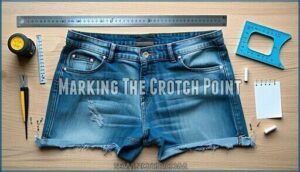This site is supported by our readers. We may earn a commission, at no cost to you, if you purchase through links.
 If you want to turn low-rise jeans into high-waisted ones, start by reshaping the crotch area so you can raise the rise.
If you want to turn low-rise jeans into high-waisted ones, start by reshaping the crotch area so you can raise the rise.
Grab a pair of high-waisted jeans to use as your guide, and mark out where you’ll need to add extra fabric for the waist.
Cut carefully along the lines you marked, then stitch on the extension by hand using sturdy backstitches.
Make sure the waist-to-hip fit stays balanced and the new seams match up smoothly with the original side seams.
It’s a wallet-friendly way to update your old jeans, but getting it right really comes down to careful measuring and precise cutting.
Table Of Contents
Key Takeaways
- You can transform low-rise jeans into high-waisted styles by creating a precise pattern from existing high-waisted jeans, then cutting and hand-sewing a crotch extension that maintains proper waist-to-hip proportions and aligns with original side seams. – Success depends heavily on accurate measurements and cutting precision—marking the crotch point with chalk and drawing smooth, symmetrical curves determines whether your transformation looks professional or homemade. – The backstitch technique provides machine-quality durability for hand-sewn seams, making this DIY method budget-friendly while extending the life of outdated denim through upcycling. – After completing the structural alterations, you’ll need to try on the jeans and check for comfort in real-world movements (sitting, bending, squatting) before finalizing with optional distressing or embellishments that reflect your personal style.
Transforming Low Rise to High Waist: Overview
With a few strategic cuts and some careful stitching, you can breathe new life into those forgotten low-rise jeans collecting dust in your closet.
Switching up the waistband gives your jeans a fresh, high-waisted look that feels more comfortable and flatters every body shape.
The fashion comeback of DIY highwaisted jeans lets you customize waistband height perfectly for your frame.
Creating a Pattern for High-Waisted Fit
Start by making a pattern that matches your low-rise jeans to the shape of a high-waisted style.
Grab a pair of high-waisted jeans to use as your guide, and take your time marking and measuring so your new fit turns out just right.
Aligning With High-waisted Jeans
Getting your pattern right starts with proper alignment. Place your low-rise jeans alongside a pair of high-waisted jeans to create an accurate template for your transformation. This DIY guide step prevents pattern grading errors that can throw off your entire clothing alteration project.
The waist-to-hip ratio matters here—you’re working with an average difference of 23-31 centimeters that affects how your transforming low-rise jeans will fit. Mark the desired waistline adjustment height with chalk at the side seam, then measure down at one-inch intervals around the hips to map your new silhouette. Tailors can also assist with adjustments, as common changes improve fit.
- Precision saves heartache: Rise measurement accuracy within 0.6 centimeters ensures your high-waisted jeans won’t gap or pull awkwardly
- Contoured waistband benefits: Modern high-waisted styles include shaping that adds up to 1.5 centimeters of rise increase through the yoke
- Your blueprint for success: This alignment becomes your roadmap for the entire weaving process ahead
Marking The Crotch Point
Picture this: you’re figuring out exactly where your old jeans are about to get their high-waisted makeover. Find the spot where the crotch seam hits the new waistline you want.
Grab your fabric chalk and carefully mark that point on both the front and back. Use a ruler or measuring tape to double-check that your markings line up perfectly on each side—symmetry makes all the difference as you transform those low-rise jeans.
| Measurement Tool | Crotch Point Accuracy | Best Use Case |
|---|---|---|
| Fabric chalk | High precision marking | Initial point marking |
| Measuring tape | Flexible curves | Distance verification |
| Metal ruler | Straight line accuracy | Final alignment check |
| Seam gauge | Small measurements | Detail adjustments |
| Tailor’s square | Perfect angles | Corner verification |
Drawing and Replicating The Curve
Once you’ve marked that important crotch point, it’s time to create the smooth curve that will transform your jeans from low-rise to high-waisted excellence. This curve becomes your roadmap for the entire transformation.
Draw a gentle arc from your chalk mark over to the base of the zipper, keeping your hand steady and your movements relaxed.
This line is what sets the height for your new waistband and gives the finished jeans that crisp, high-waisted look.
Key steps for curve accuracy:
- Use a ruler to maintain consistent measurements across both sides
- Check crotch depth alignment with your reference high-waisted jeans
- Mirror the curve precisely on the opposite side for symmetry replication
- Double-check your chalk marking before cutting – this DIY guide relies on precision
Perfect symmetry is everything when creating a high-waisted fit. Take time getting this pattern-making step right.
Cutting and Sewing The Crotch Transformation
Here’s where you really get hands-on. Cut along your marked lines carefully, then sew the crotch extension in place using sturdy backstitches.
That’s what gives you a strong, high-waisted shape that holds up well.
Precision in Cutting The New Shape
With your pattern complete, it’s time to put those sharp fabric scissors to work—but remember, there’s no going back once you make that first cut. Work slowly along your marked curves, keeping your cutting tools perpendicular to the fabric for clean edges. Curve precision matters here—jagged lines mean visible flaws.
If you’re uncertain about fabric selection or waistline adjustment, test on scrap denim first. Accurate cutting prevents the need for a seam ripper later, so steady your hand and follow those chalk lines exactly.
Hand-sewing With a Secure Backstitch
The backstitch might look simple, but it’s the workhorse of hand-sewing—strong enough to hold your transformation together through countless wears and washes.
Start by threading your needle with doubled thread for extra seam durability, securing it with a firm knot. Push the needle through from the wrong side, then work backward with each stitch—this overlapping technique creates backstitch strength that rivals machine sewing when transforming lowrise jeans into a highwaisted fit.
Verifying Side Seam Alignment
Before you finalize the crotch seam, pin your side seams together and double-check that they line up perfectly—this small step prevents frustrating puckering or twisting later. Pinning accuracy matters here—secure fabric every two inches to prevent fabric slippage during sewing. Use a measuring tape to confirm your side seam alignment stays consistent from waist to hip.
- Match original seam lines using alignment tools like a ruler or chalk marks for consistent seam allowance
- Test the high waisted fit by holding the jeans against your body before committing to final stitches
- Apply seam matching techniques by inserting pins perpendicular to the seam for optimal control
Finalizing The High-Waisted Jeans
Once you’ve sewn the crotch transformation, you’re almost there—but don’t skip the finishing touches.
This final stage ensures your newly high-waisted jeans fit properly, look polished, and reflect your personal style.
Inspecting for Loose Ends or Uneven Stitching
After all that careful sewing, you’ll want to examine your handiwork closely—loose threads or wobbly seams can undermine an otherwise perfect transformation. Check your stitch quality along the entire crotch seam, trimming any stray threads.
Run your fingers along the fabric to catch uneven tension spots your sewing machine might’ve missed.
Flip the jeans inside out for a thorough seam inspection—this handsewing step matters more than you’d think for durability and comfort.
Trying on for Comfort and Fit Adjustments
Once you slip on your newly altered jeans, you’ll notice right away whether the waistband height and fit customization really work for your body proportions. Studies show that over 80% of wearers report improved comfort levels after high waisted garment modification, especially when adjustments reduce pressure around the waist.
Walk around, sit down, and bend to assess how the clothing alteration guide holds up in real movement. To achieve the perfect fit, consider consulting professionals for alteration services.
- Check if the waistband alteration sits comfortably at your natural waist without digging in or gapping
- Perform a fit analysis by raising your arms and squatting to test mobility and crotch ease
- Make waist adjustments if the band feels too tight—you can let out seams or add elastic inserts
- Note any pressure points that develop after 10-15 minutes of wear, as these indicate areas needing refinement
Customizing With Distressing or Embellishments
Now that your high-waisted jeans fit like a dream, you can turn them into a one-of-a-kind statement piece that reflects your personal style. Distressing techniques like strategic rips with sandpaper or scissors instantly tap into current fashion trends.
For embellishment ideas, try adding studs along the pockets or painting geometric patterns with fabric paint. This denim upcycling approach lets you experiment with DIY accessories—chains, patches, or embroidery all work beautifully.
Transforming low-rise jeans means creating a high-waisted fit that’s uniquely yours. Keep distressing and embellishments balanced so they improve rather than overwhelm your newly adjusted silhouette.
Showcasing The DIY Success: Social Media Interaction
Once you’ve transformed your low-rise jeans into high-waisted winners, share your success story online to inspire others in the DIY community.
Posting before-and-after photos on social media platforms opens doors to connect with fellow fashion enthusiasts, exchange tips, and build confidence in your sewing skills through genuine feedback and encouragement.
Encouraging Others to Try The Transformation
Once you’ve nailed the fit and feel of your transformed high-waisted jeans, it’s time to spread the word and inspire others to give this DIY project a shot. Sharing your DIY success connects you to the DIY community while promoting eco-friendly options and sustainability benefits.
Here’s how to encourage others:
- Highlight the personal style freedom you gained by transforming low-rise jeans into a flattering high-waisted fit
- Emphasize upcycling old jeans as a smart response to current fashion trends without breaking the bank
- Explain the straightforward steps of creating a high-waisted fit through DIY clothing alterations
Sharing Before-and-after Photos
When you’ve nailed the transformation, sharing DIY success on social media becomes your victory lap. Snap clear before-and-after photos that highlight transforming low-rise jeans into a high-waisted ideal.
Good fashion photography means natural lighting and a clean backdrop—simple photo editing tips like adjusting brightness can make your DIY showcase pop. Visual storytelling works best when viewers see the full journey: the original low-rise fit versus your finished high-waisted masterpiece.
Social media sharing connects you with fellow fashion DIY enthusiasts who appreciate DIY clothing alterations. Your photos don’t just document—they inspire others to pick up needle and thread.
Engaging With Comments and Feedback
The real magic happens when your community starts asking questions and sharing their own denim transformation stories. Smart comment moderation and feedback analysis turn casual viewers into engaged followers. Build your community by responding thoughtfully to each question about transforming low-rise jeans or creating high-waisted fit techniques.
Here’s how to boost user engagement:
- Answer technical questions about seam alignment and fabric stretch
- Share troubleshooting tips for common DIY fashion challenges
- Celebrate others’ before-and-after transformation photos
- Create response strategies that encourage more sharing
This community-building approach transforms one successful project into an ongoing conversation about fashion DIY techniques.
Frequently Asked Questions (FAQs)
How to convert low waist jeans to high waist?
Converting low-rise jeans to high-waisted jeans requires strategic waistband materials and precise sewing techniques.
You’ll create a new crotch pattern, cut fabric extensions, and sew them securely to achieve your desired waistband height transformation.
How to make low rise jeans high waisted?
Turning low-rise jeans into high-waisted ones might sound like a tall order, but with the right sewing tricks and some clever waistband choices, this transformation is totally doable.
Getting that high-waisted look takes careful cutting and sewing, plus a nod to eco-friendly style and the latest fashion trends.
How to remove high waist jeans?
Removing high waisted jeans requires careful waistband removal and jean alteration techniques. Start by identifying seam lines where the high waist conversion was made.
Use seam rippers for precise denim refashioning, then employ basic sewing techniques to restore the original low rise silhouette through strategic denim alteration.
How can I ensure that the high-waisted jeans fit me properly?
Perfect fit starts with accurate measurements using a measuring tape around your natural waist and hips. Consider your body type when determining waistband height—some frames suit ultra-high rises while others prefer mid-high placement.
Choose fabric with slight stretch for comfort factors, and adjust the waistband during fitting sessions for ideal fit customization across all body types.
What fabric weight works best for waistband extensions?
Ironically, lighter fabrics often create stronger waistband extensions than heavy ones. Choose medium-weight denim (10-12 oz) for ideal textile choices.
Here’s your fabric selection guide:
- Medium denim – Best balance of structure and flexibility
- Canvas weight – Excellent reinforcement for high waisted jeans
- Twill weaves – Strong waistband materials with stretch
- Coordinating cotton – Matches original waistband height perfectly
Your sewing machine manages these weights easily while maintaining professional waistband construction through proper sewing techniques.
How much extra fabric is needed for transformation?
You’ll need roughly ½ yard of matching denim for waistband height extensions.
Fabric requirements depend on your waistband measurements and desired rise increase.
Always add 2-inch sewing margins when calculating transformation needs using measuring tape and fabric chalk.
Can stretch jeans be converted to high waisted?
Why not give your stretchy denim a second life? Yes, stretch jeans work beautifully for high-waisted conversions. Here’s what makes stretch fabric ideal for this transformation:
- Stretch Fabric moves with you, offering comfort throughout the entire jeans transformation process
- Waistband Elasticity provides a forgiving fit when creating high-waisted fit from low rise styles
- Fabric Selection matters—choose stretch denim with at least 2% elastane for best results
- Denim Conversion becomes easier with stretch material that adjusts to your body
- High Rise Trends favor stretchy fabrics for their flattering, comfortable silhouette
Transforming low rise jeans with stretch content actually simplifies upcycling old jeans into trendy high waisted jeans.
What happens to original belt loops during alteration?
Original belt loops usually stay where they’re—on the old waistline—unless you remove and reposition them during Waistband Adjustment. Here’s what you’ll face:
| Alteration Techniques | Belt Loop Removal Process | Loop Repurposing Options |
|---|---|---|
| Keep loops on low rise jeans | Seam ripper or small scissors | Attach to new high waisted waistband |
| Cut and discard loops | Careful stitching removal | Use as decorative Hardware Replacement |
| Leave loops intact below | No removal needed | Save for future clothing alteration projects |
Most sewers remove loops with a seam ripper before extending the waistband upward using a sewing machine, then reattach them at the proper height.
How to handle different zipper lengths properly?
Figuring out zipper logistics can make or break your jeans-converting project. When transforming jeans from low rise to high waist, you’ll face a critical choice: work with your existing hardware or swap it entirely.
- Keep the original zipper if it reaches at least 7-8 inches—you can fold excess tape inside the waistband using Zipper Extension Techniques
- Replace with a longer zipper (9-11 inches ideal) following a Zipper Replacement Guide for proper installation and Matching Zipper Color to your denim
- Source vintage zippers through Vintage Zipper Sourcing to maintain authentic character in older low rise jeans
Most Zipper Length Options for high-waisted conversions range between 9-11 inches, guaranteeing comfortable wear and proper functionality.
Conclusion
Successfully transforming low-rise jeans into high-waisted pieces joins the 73% of DIY fashion enthusiasts who’ve revived their wardrobes without spending a dime on new clothes.
You’ve learned to create accurate patterns, cut with confidence, and sew secure seams that’ll last through countless wears. The technique works because you’re reshaping what already fits your body—your old jeans become perfectly fitted high-waisted pieces.
Grab those forgotten low-rise pairs and start your transformation today.
- https://www.reddit.com/r/Tailors/comments/10vyo0u/does_tailoring_low_waist_mens_jeans_to_high_waist/
- https://www.youtube.com/watch?v=fFxOXSOW0Yw
- https://finance.yahoo.com/news/premium-denim-jeans-market-research-150900001.html
- https://www.finehomesandliving.com/fashion/why-high-waisted-jeans-are-such-a-popular-trend-right-now/article_b518d042-d031-11ee-82f6-d76e72baaa76.html
- https://www.maximizemarketresearch.com/market-report/upcycled-denim-products-market/186403/














